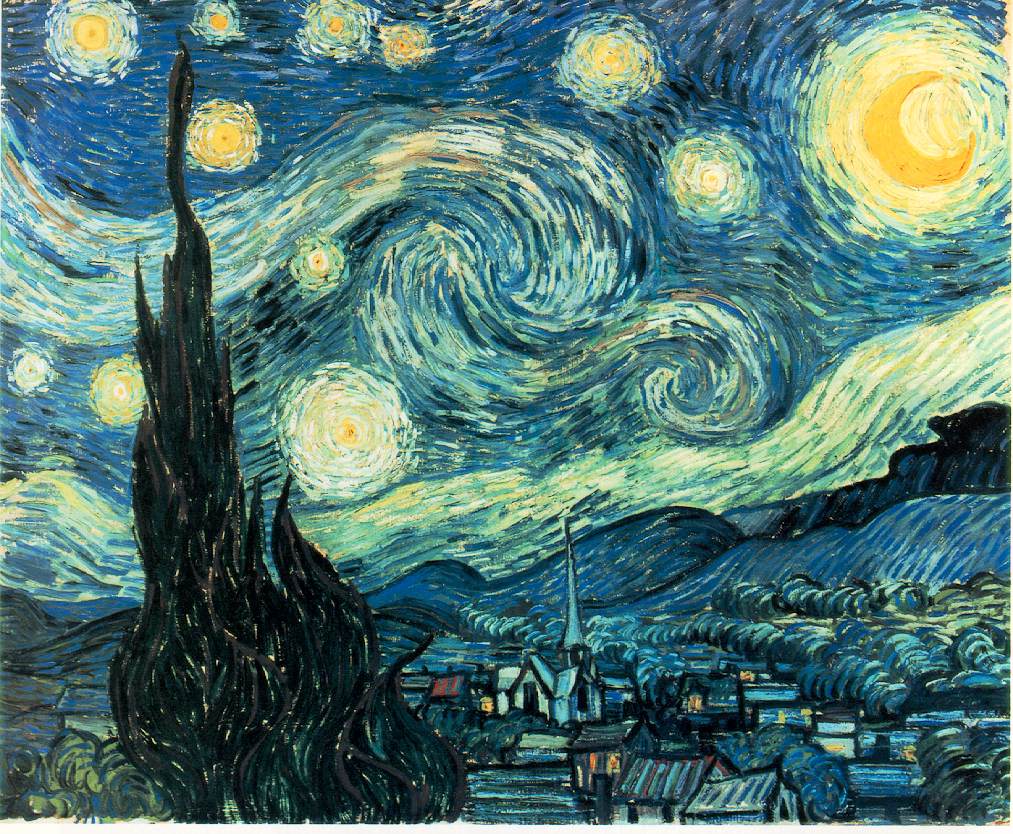Lessons in Composition for the Art Photographer
Version 2.3, Page 4, ©2001 by Dale Cotton, all rights reserved.
Lesson 1: Unity and Cohesiveness versus Fragmentation (continued)

Starry Night by Vincent Van Gogh
Few of us have not seen a reproduction of the painting Starry Night by Vincent Van Gogh. Each star is the centre of a vortex of paint. One might suspect that the painter had astigmatism or was on a drug trip. In fact Vincent was freeing himself from the confines of strict literalism - but not for the egoistic purpose of defining a unique "style". He was instead grappling with the issue of unity versus fragmentation. A literal, photographic, representation of the scene with sky above, land below, and the vertical cypress would have created a fairly fragmented composition. The three parts of the picture would not have had much to say to each other. Van Gogh might have rhymed the moon in the sky with something of both similar shape and colour in the lower - land - half of the picture (perhaps even the moon's reflection on water). He might have left the stars as white points mirrored by gleams of light in the village or on water. But the energy of impressionism was in the air of his era. Like Monet, Seurat, Cezanne, et al., Van Gogh took the power upon himself to interpret the scene before him. After centuries of striving for what we would now call photo-realism artists began moving back to a deliberate primitivism. They recognised that something like the Bayeux Tapestry may have been representationally crude but was artistically powerful.
Starry Night is an epic, a major battle, on the theme of unity and fragmentation. Notice how each brush stroke is similar in shape - long, narrow, slightly curved - and clearly defined. The picture is essentially a two-dimensional tiled mosaic created from hundreds of nearly identical brush strokes that vary mainly in colour. Also note that the same colours are repeated in sky and land. These two techniques create a massive foundation of cohesion that gives Vincent the freedom to erect almost anything he wants upon that foundation. Building upon that foundation, he almost systematically starts pushing things to extremes. The cypress, massive and dark, very nearly fragments itself from the rest of the picture. Its composition from long brush strokes, together with the rhyme of shape and colour in the horizontal dark mountain to middle right, together with the faint shape-only echo in the steeple, are the only elements that anchor it to the rest of the picture. The moon and each star are monstrously exaggerated. Their circular shapes isolate each of them both from the others and the rest of the picture. They too teeter on the brink of total fragmentation. They too are pulled back from the brink by the twin rhymes of brush stroke tiling and colour repetition.
As a photographer it is possible to work impressionistically, especially in post-processing. I am not encouraging (or discouraging) that. Rather, my point is that you need to be aware of the issues involved - the tension between unification and fragmentation - in every image you create. If one succeeds too well at unification the reward is almost certainly a boring composition. You are looking for a degree of energy or movement, and a composition that verges on fragmenting will certainly possess energy.